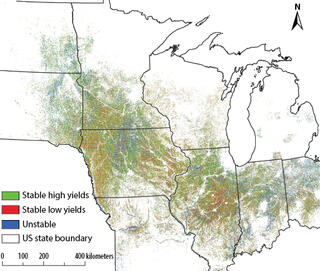Yield stability analysis reveals sources of large-scale nitrogen loss from the US Midwest

Matching fertilizer rates to field production levels could reduce nitrogen loss with no impact on crop yield, thereby enhancing the sustainability of some cropping systems.
The Science
Great Lakes Bioenergy Research Center (GLBRC) investigators have developed an approach to classify croplands across the Midwest depending on yield, making it possible to estimate the amount of nitrogen (N) loss in areas of high, low or unstable yield due to over-fertilization. The team recommends a variable rate of N application depending on field quality to prevent these losses.
The Impact
Reducing fertilizer application in areas that produce low and variable yields could decrease N loss substantially with no impact on harvests. This practice would save farmers money, reduce greenhouse gas emissions, and decrease N runoff into water systems.
Summary
Corn and soybean fields with low and variable harvests don’t respond as well to N fertilizer application as fields with consistently high yields. Still, pressure on farmers to increase crop output for greater economic return often leads to excessive fertilizer application on these non-fertile lands, despite the economic and environmental cost. Using eight years of satellite imagery, field boundaries, and crop data, GLBRC researchers established that approximately 46% of land farmed for corn and soybean use was high-yielding, 26% consisted of stable low yielding lands, and 28% could be classified as unstable yields. With data reported by U.S. farmers to the USDA in conjunction with state-by-state university-based recommendations, the investigators then estimated the amount of fertilizer uniformly applied to determine overfertilization rates. Low-yielding areas contributed to the highest N loss to the environment – approximately 44% of the total, with another 31% lost from unstable fields during years of poor production. The team estimates that overfertilization in low and variable yielding areas poses a total loss of approximately $485 million in fertilizer value to farmers, corresponding to greenhouse gas emissions estimated at 6.8 MMT CO2 equivalents. N fertilizer recommendations based on yield stability class could thus provide substantial savings. Non-commercial satellite imagery sufficient to generate yield stability maps is available for most if not all fields in the U.S., and most grain farmers also have access to harvest combine monitors that can produce annual yield maps for individual fields with even greater precision than satellite imagery. Once stable low yield areas are identified, N fertilizer rates could be adjusted downward to match consistently low crop yields in those areas and thereby reduce both economic costs and environmental harm. In unstable yield areas, a modeling-based strategy that, at the time of fertilization, incorporates recent and projected weather could be used to better match N fertilizer rates to that year’s expected crop needs mid-season. Performing this analysis for other inputs such as phosphorus, lime, seeds, herbicides, and labor may show that stable low yielding areas are not only environmentally vulnerable but are also economically unprofitable. In such cases it may be that these areas are better planted to conservation strips or, in the future, to perennial biofuel crops.
Program Manager
N. Kent Peters
Program Manager, Office of Biological and Environmental Research
kent.peters@science.doe.gov, 301-903-5549
Corresponding Author
Bruno Basso
Michigan State University
basso@msu.edu
Funding
Financial support was provided by USDA/NIFA (award 2015-68007-23133), the U.S. National Science Foundation’s Dynamics of Coupled Natural and Human Systems Program (award 1313677), the NSF Long-term Ecological Research Program (award 1637653), the U.S. Department of Energy, Office of Science, Office of Biological and Environmental Research (awards DE-SC0018409 and DE-FC02-07ER64494), and Michigan State University AgBioResearch.
Publications
B. Basso, G. Shuai, J. Zhang & G. Philip Robertson, “Yield stability analysis reveals sources of large-scale nitrogen loss from the US Midwest.” Nature Scientific Reports 10, 5774 (2019). DOI:10.1038/s41598-019-42271-1.